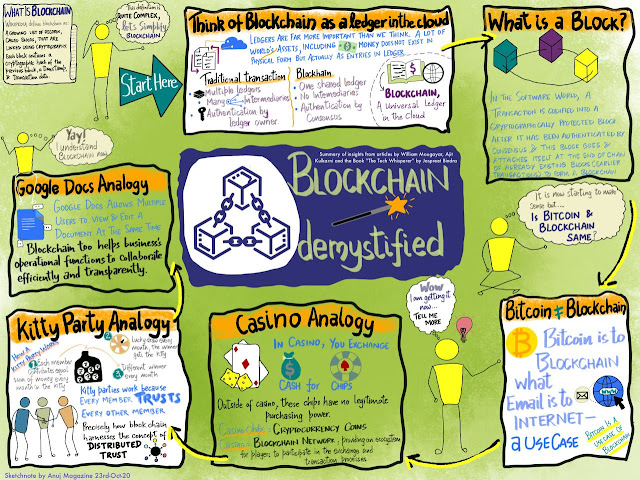Estonia, a tiny country of 1.3 million people, was referred to as the 'most advanced digital society in the world' by the Wired magazine. Estonia was the first Nation-State in the world to deploy blockchain technology in production systems – in 2012(more details here https://pwc.to/2FTDEPH).
With all the buzz around #Blockchain and newer use cases emerging, it is a technology that is approaching 'Plateau of Productivity' in the Gartner Hype Cycle.
How would you explain a technical term like #Blockchain to an non-Technical audience ?
Drawing inspiration from the examples in our day-to-day lives usually is of great help in simplifying a complex concept.
In the book on Digital Transformation, 'The Tech Whisperer' Jaspreet Bindra beautifully explains the concept of Blockchain using analogies such as- Ledger, Kitty Party (yes you heard it right!) to explain Blockchain.
A few other analogies that i found useful were Casino and Google docs. To elaborate one of them (rest in my #sketchnote below), Casino chips can be thought of as cryptocurrency coins, and the casino as the blockchain network providing an ecosystem for players to participate in the exchange and transaction processes.
How else would you simplify technology ?
More details:
Defining blockchain
The Free Dictionary helpful says that, Blockchain is a distributed ledger that provides verifiable proof of transaction. There is no central repository. The blockchain is replicated on many nodes dedicated to that platform.
Gartner defines it as .. an expanding list of cryptographically signed, irrevocable transactional records shared by all participants in a network'.
One of my favourite definitions is that it is a distributed database shared among a network of computers, all of which must approve a transaction before it can be recorded."
All good, but it is a bit like defining the Internet as a connected network of all computers. Accurate, but does not mean much.
Ledger Analogy:
The blockchain as a universal ledger
There are many ways to think of blockchain. One of the best ways is to visualize it is as a 'universal ledger in the cloud'. I am sure you know what a ledger is. Try and visualize it thick, musty, yellowing book with large pages filled with little entries is perhaps what comes to mind. Actually, ledgers are
Why is it called Blockchain?:
In the software world, a transaction, or a set of transactions, is codified into a cryptographically protected block after it has been authenticated by a consensus, and this block goes and attaches itself at the end of a chain of already existing blocks (previous sets of transactions), to therefore form a blockchain, Therefore, the name blockchain. The authentication is done.
Is Bitcoin same as Blockchain?
Bitcoin is to Blockchain what email is to Internet. A use case. Bitcoin is a use case of Blockchain.
Analogy: Casino
Another helpful metaphor from Ajit Kulkarni to explain a fundamental difference between blockchain and cryptocurrency to a beginner is by imagining yourself in a casino. The process begins with exchanging cash for chips or tokens that can only be used to gamble at the casino. Outside the building, these chips have no legitimate purchasing power.
In this example, the casino chips are cryptocurrency coins, and the casino is the blockchain network providing an ecosystem for players to participate in the exchange and transaction processes.
Blockchain attributes:
The above attributes are built in the very construction or architecture of blockchain. In addition, many of them, notably the Ethereum blockchain (the second largest blockchain after Bitcoin) also have an in-built algorithmic logic of if this, then that' (IFTT) built in. These 'smart contracts' are useful to actuate transactions and actions if certain conditions are met. The above five attributes of consensus, provenance, immutability, smart contracts, and security and trust are what characterize and distinguish blockchain from other technology constructs.
Google Docs:
Google Docs made its appeal due to its efficient collaborative feature that allows multiple users to view and edit a document at the same time. It reduces the lead time of waiting the other party to receive, view, edit and send the document back. Normally, the software being used is Microsoft Word. Most databases in the world today still work like Microsoft Word: access and edits can only be made by one person at a time, while everyone else is locked out. Like Google Docs, blockchain solves the issue by updating any changes for everyone to see in real time.
Based on this metaphor, you can view blockchain as simply a technology, a powerful tool that helps business’s operational functions to collaborate efficiently. For instance, applying blockchain technology in the banking institution would allow any money transfers to be simultaneously verified on both ends.
Five attributes of Blockchain:
consensus,
provenance,
immutability,
smart contracts,
and security
References:
The Book: Tech Whisperer by Jaspreet Bindra














